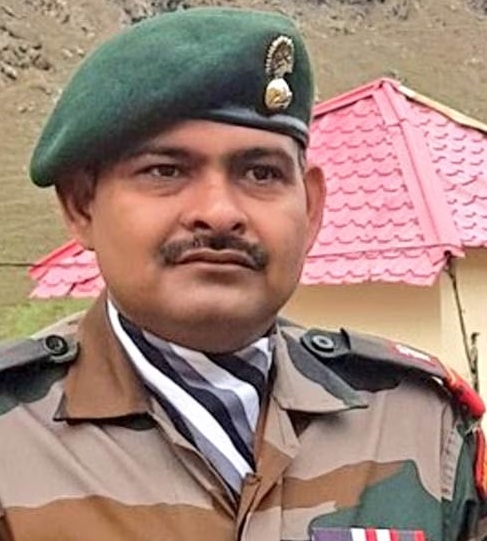The youngest recipient of PVC
| Date :14-Nov-2023 |

Dateline Kargil-9
By Kartik Lokhande :
HEROES OF KARGIL
He was hit by a burst of machine gun fire. Undaunted, he charged towards the enemy bunker, lobbed grenade inside it, and fired from his weapon, killing four Pakistanis in close combat, and silenced the automatic fire
Stories of valour can inspire children to become heroes in life. Yogendra Singh Yadav and his brother Jitendra Singh Yadav, grew up listening to the stories of valour narrated by their father Ram Karan Singh, who had served with 11 Kumaon as a soldiers and was active in the India-Pakistan wars of 1965 and 1971. And, when the time came in 1999, Grenadier Yogendra Singh Yadav made his bloodline proud by scripting a story of valour to be told by others to their kids.
Born on May 10, 1980 in village Aurangabad near town of Ahir in Bulandshahr in Uttar Pradesh, Yogendra Singh Yadav wanted to join the Indian Army as he was inspired by the stories of valour and courage told by his father. His elder brother also joined the Indian Army in the Artillery regiment. At the tender age of 16 years, when most youngsters think of owning gadgets or getting lost in the world of dreams, Yogendra Singh Yadav joined the Grenadiers Regiment on December 27, 1996.
When the Kargil war broke out, Grenadier Yogendra Singh Yadav was only 19 years of age and only around three years old in the service.
His unit, 18 Grenadiers, which had already lost two brave officers namely Lt Col R Vishwanathan and Major Rajesh Singh Adhikari during the Tololing operations, was given the ‘near impossible’ task of capturing the Tiger Hill on the night of July 3/4, 1999.
Tiger Hill is a massive feature that dominates the Srinagar-Leh highway. Tiger Hill Top is a conical feature about one km at its base from where it rises sharply to its peak. The feature was a vital position, which the enemy held, as it overlooks the Mashkoh valley, Matayin bowl, and Drass village. Since the Kargil war was the first televised war of India, the media coverage had built an aura of ‘invincibility’ around this feature.
On July 3, around 7 pm, the multi-directional attacks commenced in
freezing rain. The 12-hour vertical climb from southern to north-eastern approach involved using fixed ropes. Lt Balwan Singh led the Ghatak Platoon of 18 Grenadiers from the highly dangerous north-eastern approach. Grenadier Yogendra Singh Yadav was the lead Ghatak, as he had volunteered to lead and fix the ropes to pave way for further assault on the feature. The Ghatak Platoon had been given a crash course in high altitude climbing, at High Altitude Warfare School.
They had barely reached halfway, when the enemy opened ‘intense automatic, grenade, rocket and artillery fire’, leaving the team commander and two other soldiers wounded. The approach to the top, at a height of 16,500 feet, was steep, snowbound and rocky. If the advance was stalled, the task would seem more difficult. So, Grenadier Yogendra Singh Yadav continued to climb, realising the gravity of the situation. He was hit by a burst of machine gun fire. Undaunted, he charged towards the enemy bunker, lobbed grenade inside it, and fired from his weapon, killing four Pakistani soldiers in close combat, and silenced the automatic fire. During the charge, he again sustained multiple bullet injuries, but refused to be evacuated even in critical condition at icy heights. A
s is recorded, this inspired the rest of the Ghatak Platoon to charge on the other positions. This led to the capture of Tiger Hill Top, which had become a national objective. The ‘invincible’ and ‘near impossible’ task was made possible by one man’s bravery amid hail of bullets. “I have lived those moments. That time, no other thought came to my mind except that the mission had to be accomplished. You must have seen it in movies that even a soldier whose head gets severed in action keeps firing for a while. I have seen these things happen during intense action.
When in action, soldiers think only of contributing to victory and nothing else. Despite casualties, we mounted attack at Tiger Hill Top and captured it,” Honorary Captain Yogendra Singh Yadav (Retd) had told ‘The Hitavada’ in an interaction when he had visited Nagpur in February 2022. He is India’s living legend. He was decorated with the Param Vir Chakra (PVC) at the age of 19 years only, making him the youngest recipient of the highest gallantry medal of the country. He retired as Honorary Captain. He is among the only three living awardees of the PVC. Though he retired from the uniformed service, he keeps inspiring confidence among the youths about the Indian Armed Forces. For, he feels that everyone is a soldier, with or without uniform. (To be continued)